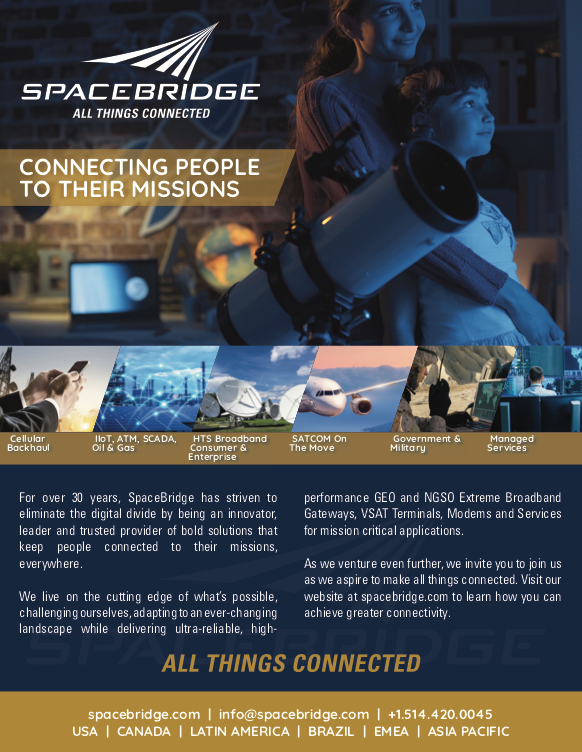Over the years, the SATCOM and MILSATCOM market segments have developed a whole host of tools and processes for dealing with satellite interference. These range from proactive measures such as employee training, bilateral coordination and antenna type approvals, to reactive and proactive measures that enable operators to detect and resolve the interference once it occurs.

Interference has certainly not gone away; however, operators are better equipped to manage it than they were just a few years ago. That said, it continues to cause service degradation and cost operators precious time and resources. How do we get better? Could Artificial Intelligence (AI) be the answer?
The Potential of AI
AI has long been touted as the next best thing for many applications, from resolving issues to creating efficiencies. While many people have seen its potential for a number of years, the technology is steadily improving, thus increasing its value as a tool for various applications. According to an article in Information Age, 2021 will see some significant developments with AI being used especially in construction, to fight climate change, and in medical applications. But what about the satellite industry?

To date, the satellite industry has not really fully embraced the potential of AI. I find that surprising in many ways, because if there is one thing you need for AI to work well, it is good data, and that is something the SATCOM industry has in abundance, but perhaps that lies in the complexity and sensitivity of the data. As the technology improves, maybe that is starting to shift.
There is certainly movement in the correct direction. Toward the end of last year, CGI was awarded a contract by ESA to develop an AI enabled platform for global SATCOM.
There have already been a number of research projects undertaken looking at its potential for SATCOM. I personally remember a number of presentations at our various workshops with research into applications, mainly focused on error resolution. For example, the Centre Tecnològic de Telecomunicacions de Catalunya (CTTC) presented how it has been using Signal Correlation, Machine Learning (ML) and AI to compare RF signals for interference detection.
AI to Resolve Interference
When it comes to resolving interference, AI can have two major uses to help operators. On the one hand, it can be used for interference prediction. This is about using data from both operations measurements or alarm systems and many external sources such as certain calendar events or decision making outside of SATCOM related topics to classify interference scenarios.
As such, the system can raise an alert when the probability of a certain event is imminent. Of course, this all starts with having usable data (past and present) in the first place, analysing that data then using machine learning to build an interference scenario repository. It is at that point we get to apply AI resolve the probabilities of scenarios occurring and thus create an advanced warning system.
All over, we need to tell the AI algorithm what it shall look for and let it learn with that to answer further questions — but never fully autonomously as we need to check upon the quality of decision making.
This could go a step further and suggest possible ways to resolve a particular interference scenario.
Such an approach has been successfully demonstrated by CTTC. It began by demonstrating automated GSM interference retransmission detection based on I/Q samples and has since carried out projects to identify other types of interference correlation, such as ASI and XPOL. This means that interference detection and analysis can be done in the background without needing human intervention at that initial stage.
While being able to predict interference issues faster is certainly going to help reducing any impact and being able to proactively allow advanced warning of any likely situations from occurring in the first place. For example, by correlation of the current situation with past similar events, looking at potentially probable future fixed events in the calendar.
Pilot projects have already been started to find the right mathematical correlation functions using the right input data we have. With enhanced techniques as ML, we are ready to take AI a step further. To get to that point, how do we translate those initial steps into reality now?
The Must Haves
It is not enough to do AI for the sake of AI. There are a number of key factors that need to be carefully considered before embarking on such a project.
1. Does the person operating the AI tool understand the manual process?
It is absolutely critical that the operator knows what they are doing manually. If that is not the case, they will not be able to easily spot any errors with the AI tool and they will not be able to react and manually carry out the process being automated without that. AI is the “digital assistant” to any operations. It is only useful if it is eventually used more often than it is ignored.
2. Can the AI be manually overridden?
The idea of AI being used in space and not being able to be overridden is quite frankly very scary. As well as ensuring the person operating the AI tool understands the manual process, it is important to have an infrastructure in place to enable manual intervention. If we push automation so far that decision making is revoked, then the potential for it to go wrong is huge, and that is something we can ill afford in the satellite environment.
3. Is the data quality good enough?
As mentioned above, in the satellite environment we certainly have a lot of data. That data used must be processed to produce reliable scenarios that an AI system can produce well qualified results giving accurate and high probability of future events. For AI to be useful we need to avoid too much manual interaction — by definition for what ever reason. Once it could be that the input data is of poor quality and the AI process can’t find a solution automatically, another time, it could be that the AI algorithm is not performant enough for the issue in which we want AI to help us.
4. Does AI make the process more efficient?
Ultimately the entire point of using automation and AI is to make processes more efficient, free up time from your staff dealing with those difficult cases and save costs. It is important, therefore, to assess and compare how much efficiency is gained. If the increase is not significant, there is not enough value to warrant the time and expense to implement an AI system.

The Future of Interference Mitigation

There is certainly a great deal of potential for AI in interference scenario detection and prediction. Any tools developed must ensure maximum efficiency without removing human intervention. If we can harvest the huge volumes of data available of interference instances, we can eventually train AI algorithms to be extremely effective at spotting those future event pattern probabilities by their own mathematics.
satig.space
Author Helen Weedon is the Managing Director of the Satcoms Innovation Group (SIG)

